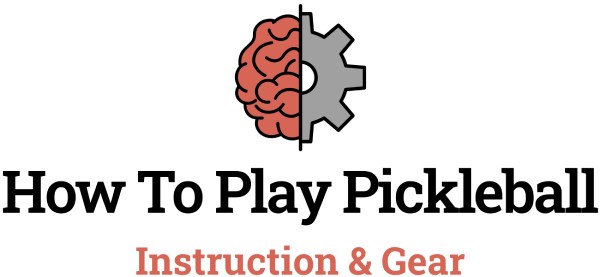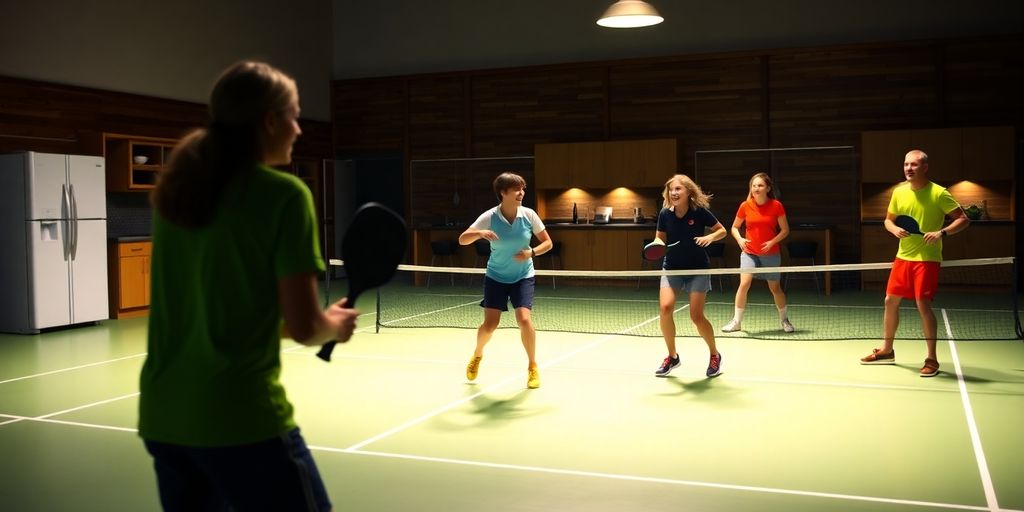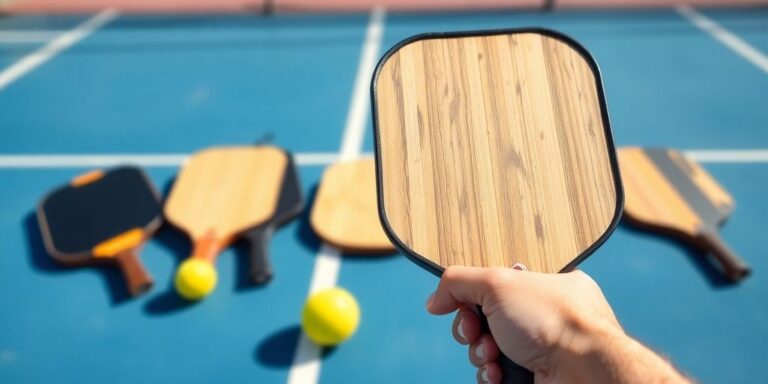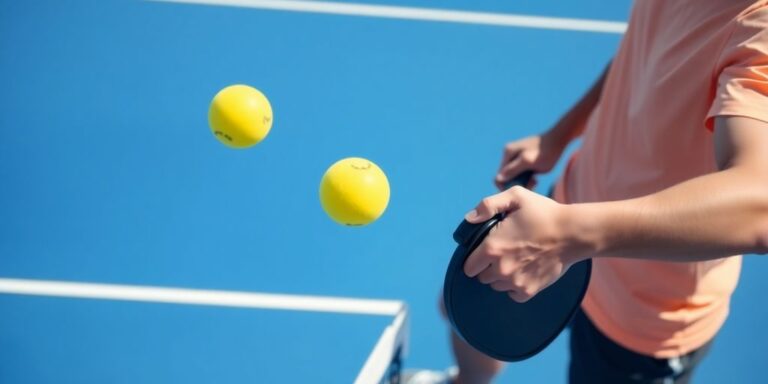Pickleball is taking the world by storm, and if you’re getting into it, there’s one thing you need to know: the kitchen rules. These rules are what make pickleball unique and fun, but they can also be a bit tricky to wrap your head around. The kitchen, also known as the non-volley zone, is a special area on the court that changes the way you play the game. Whether you’re a newbie or a seasoned player, understanding these rules is key to improving your game and having a blast on the court.
Key Takeaways
- The kitchen in pickleball is a 7-foot zone by the net where volleying is not allowed.
- Players can enter the kitchen but must not volley while inside or touching the line.
- Momentum carrying a player into the kitchen after a volley results in a fault.
- Groundstrokes are allowed in the kitchen as long as the ball has bounced first.
- Communication and strategy are essential for doubles play near the kitchen.
The Basics of Pickleball Kitchen Rules
Understanding the Non-Volley Zone
The non-volley zone, commonly known as the "kitchen," is a 7-foot area on each side of the net. This zone is crucial because it restricts players from volleying, or hitting the ball out of the air, while standing within it. The intention behind this rule is to prevent players from overwhelming the net with aggressive volleys, which helps keep the game fair and encourages longer rallies.
The kitchen is where finesse and strategy come into play, demanding precise control and thoughtful shot placement.
Key Restrictions and Allowances
- No Volleying in the Kitchen: Players are not allowed to volley the ball while inside the kitchen. This includes any part of their body or paddle touching the kitchen line during a volley.
- Entering the Kitchen: Players can step into the kitchen to play a ball that has bounced, but they must exit immediately after hitting the shot to avoid a fault.
- Momentum Rules: If a player volleys from outside the kitchen and their momentum carries them into it, it’s a fault. Players must be mindful of their movement to maintain legal positioning.
- Groundstrokes Allowed: Players can perform groundstrokes (hitting the ball after it bounces) from within the kitchen, which is essential for executing strategic shots like dinks.
Common Mistakes to Avoid
- Foot Faults: Ensure that no part of your foot touches the kitchen line during a volley to avoid losing the rally.
- Momentum Mismanagement: Be aware of your momentum after a volley to prevent inadvertently stepping into the kitchen.
- Communication Gaps in Doubles: In doubles play, partners must communicate effectively to avoid both players crowding the kitchen and committing faults.
Understanding these updated rules for pickleball in 2025 is essential for avoiding common pitfalls and enhancing your game. By mastering the kitchen, players can gain a strategic edge and enjoy a more dynamic and engaging match.
Mastering the Art of Dinking in the Kitchen
Techniques for Effective Dinking
Dinking in pickleball is all about finesse and control. It’s not just about getting the ball over the net; it’s about placing it just right to keep your opponents on their toes. The key to a successful dink is to keep the ball low and slow, making it difficult for your opponent to attack. Start by practicing soft, controlled shots that land just over the net into the opponent’s kitchen. Focus on your wrist action and paddle angle to maintain control and precision. Remember, the goal is to create a shot that’s hard to return aggressively.
When to Use Dinks Strategically
Knowing when to dink is as crucial as knowing how. Dinks are best used to extend rallies and create openings for more aggressive plays. Use them when your opponent is out of position or when you want to force them to make a difficult return. In doubles, communicate with your partner to set up dinks that can disrupt your opponents’ rhythm. Successful dinking requires precision, aiming to land the ball just over the net into the opponent’s kitchen while keeping it low to avoid easy returns.
Avoiding Faults While Dinking
Faults can turn the tide of a game, so it’s important to avoid them while dinking. One common mistake is stepping into the kitchen during a volley. Always be aware of your foot placement and practice keeping your balance just behind the line. Another pitfall is hitting the ball too high, which gives your opponent an easy shot. Keep your shots low and controlled to maintain the upper hand. By understanding the kitchen rules, you can enhance your gameplay and reduce unnecessary errors.
Advanced Strategies for Kitchen Play
Using the Kitchen to Control the Game
In pickleball, the kitchen is more than just a no-volley zone; it’s a strategic area where you can control the pace of the game. By effectively using dinks and soft shots, you can keep your opponent on their toes. The key is to maintain a steady rhythm and force your opponent to play up, making it harder for them to execute powerful shots.
- Dinking: Keep your shots low and soft to make it difficult for opponents to attack.
- Positioning: Stand just behind the kitchen line, ready to move in or out as needed.
- Shot Variation: Mix dinks with occasional lobs to keep opponents guessing.
Communicating with Your Partner
Teamwork is crucial in doubles pickleball, especially when playing around the kitchen. Clear communication with your partner can prevent confusion and errors.
- Call Your Shots: Let your partner know when you’re taking a shot.
- Plan Strategies: Discuss tactics before the game to ensure both players are on the same page.
- Watch Each Other’s Backs: Be ready to cover for your partner if they get pulled out of position.
Exploiting Opponent Weaknesses
Identifying and exploiting your opponent’s weaknesses can give you the upper hand in kitchen play. Pay attention to their footwork, shot preference, and positioning.
- Footwork: Notice if they struggle with quick movements and adjust your play to exploit this.
- Shot Preference: If they favor certain shots, use this knowledge to anticipate their moves.
- Positioning: If they overcommit to the kitchen, use lobs to push them back.
Remember, the kitchen is not just a limitation but an opportunity to outsmart your opponents. By mastering these strategies, you can turn the kitchen into your playground.
The Importance of Footwork in the Kitchen
Maintaining Balance and Agility
When you’re playing pickleball, especially near the kitchen line, balance and agility are your best friends. It’s all about staying light on your feet, ready to jump into action or pull back as needed. Here are a few tips to help you keep your balance and stay agile:
- Stay on the balls of your feet: This helps you move quickly in any direction.
- Keep your knees slightly bent: This position allows for better balance and rapid changes in direction.
- Practice shifting your weight smoothly: Move your weight from one foot to the other to maintain stability.
Positioning for Optimal Play
Positioning yourself correctly is crucial when you’re at the kitchen line. You want to be close enough to the line to make effective shots but not so close that you risk stepping over it. Here’s how to find that sweet spot:
- Stand just behind the kitchen line, ready to step in for a dink or volley.
- Keep your paddle up and ready, so you’re prepared for quick exchanges.
- Watch your opponent’s movements and adjust your position to cover more of the court.
Recovering from Kitchen Faults
Mistakes happen, even to the best players. If you find yourself committing a kitchen fault, don’t worry. The key is to recover quickly and learn from it:
"Every fault is an opportunity to improve. Analyze what went wrong and adjust your strategy for the next point."
- Review your footwork: Were you too eager and stepped over the line? Practice drills that focus on foot placement.
- Stay focused: Keep your eyes on the ball and be aware of your position relative to the kitchen line.
- Communicate with your partner: If you’re playing doubles, let your partner know what happened and how you plan to adjust.
By honing your footwork skills and understanding the nuances of kitchen play, you’ll be better equipped to handle whatever your opponents throw at you. Remember, the kitchen might be a small part of the court, but mastering it can make a big difference in your game.
Etiquette and Fair Play in the Kitchen

Respecting Opponents and Rules
Playing pickleball isn’t just about skill; it’s about respect. Adhering to the kitchen rules ensures a fair game and keeps the spirit of the sport alive. Always respect the boundaries of the non-volley zone, even in casual matches. This respect not only enhances your gameplay but also makes it enjoyable for everyone involved. Remember, a game played with integrity is a game worth playing.
Handling Disputes Gracefully
Disagreements are bound to happen in any sport, and pickleball is no exception. When disputes arise, keep calm and discuss them openly with your opponent. It’s crucial to focus on the issue, not the person. If you’re unable to resolve it, consider replaying the point. This approach maintains the friendly atmosphere that pickleball is known for.
Promoting Sportsmanship
Sportsmanship is the backbone of kitchen play. Encourage your fellow players, acknowledge good shots, and be honest about your own faults. By fostering a positive environment, you ensure that everyone leaves the court with a smile. Remember, the true victory lies in playing with heart and fairness.
Training Drills to Improve Kitchen Skills

Practicing Volleys and Groundstrokes
Volleys and groundstrokes are the backbone of effective kitchen play. To sharpen these skills, try these drills:
- Volley Partners: Stand just behind the kitchen line. With a partner, volley back and forth, focusing on control and precision. Aim to keep the ball low, making it difficult for your opponent to attack.
- Groundstroke Challenge: Start at the baseline and work your way up to the kitchen line, hitting groundstrokes with a partner. This helps you practice transitioning from defensive to offensive play.
- Kitchen Line Awareness: Place a strip of tape on the ground to simulate the kitchen line. Practice volleys without stepping on the line to improve your spatial awareness.
Developing Quick Reflexes
Quick reflexes are essential for handling fast-paced exchanges at the kitchen line. Here are some exercises to boost your reaction time:
- Rapid Fire Drill: Have a partner hit balls at you quickly from the kitchen line. Focus on returning each shot with speed and accuracy.
- Reaction Wall: Stand a few feet from a wall and hit the ball against it. Try to react quickly to the rebounds, maintaining control over each shot.
- Mirror Drill: Partner up and mimic each other’s movements at the kitchen line, focusing on speed and agility.
Simulating Game Scenarios
Simulating real-game scenarios can enhance your strategic thinking and adaptability:
- Kitchen Battle: Play a game where points can only be scored through kitchen play. This forces you to focus on dinks, volleys, and strategic positioning.
- Pressure Cooker: Set up a scenario where you’re down by a few points. Practice making strategic plays to regain control and win the rally.
- Partner Communication: Engage in drills that require you and your partner to communicate effectively, deciding who takes each shot near the kitchen.
"Improving your kitchen skills isn’t just about technique; it’s about thinking ahead and staying one step ahead of your opponent. Practicing these drills can make a real difference in your game."
For more insights on essential kitchen pickleball rules and drills, you might want to explore further resources that delve into these fundamental aspects of the game. Additionally, incorporating techniques like the split step or split stop can greatly enhance your transition from baseline to kitchen line, ensuring smoother and more controlled movements.
Understanding the History and Purpose of the Kitchen
Origins of the Kitchen Rule
The term "kitchen" in pickleball is a bit of a mystery, but many believe it comes from shuffleboard, where the "kitchen" is a penalty zone. This quirky name stuck, adding a playful touch to the game. The kitchen in pickleball is a 7-foot area on each side of the net, known as the non-volley zone. Its purpose is to level the playing field by preventing players from dominating the net with aggressive volleys. By disallowing volleys within this zone, the game emphasizes strategy and finesse over raw power.
Why the Kitchen is Essential
The kitchen plays a crucial role in making pickleball accessible and enjoyable for everyone. By prohibiting volleys, it encourages longer rallies and strategic play. Players must rely on groundstrokes and dinks—soft, controlled shots—to outmaneuver opponents. This design ensures that players can’t simply overpower their way to victory, making the game more about skill and tactics. Without the kitchen, tall or skilled players might have an unfair advantage, turning the game into a one-sided affair.
Impact on Game Dynamics
The kitchen transforms pickleball into a game of patience and precision. It demands that players think several moves ahead, planning their shots carefully. The non-volley zone encourages a mix of offensive and defensive strategies, where players must decide when to attack and when to play it safe. This dynamic keeps the game engaging and unpredictable, as players constantly adapt to their opponents’ tactics. The kitchen isn’t just a rule—it’s a vital part of what makes pickleball unique and exciting.
The kitchen has a rich history and serves many important purposes in our homes. It’s not just a place to cook; it’s where families gather, share meals, and create memories. If you want to learn more about the fascinating role of kitchens throughout time, visit our website for more insights!
Wrapping Up the Kitchen Rules
So, there you have it! The kitchen in pickleball isn’t just a quirky name; it’s a game-changer. Whether you’re just starting out or have been playing for years, understanding these rules can really make a difference. Remember, it’s not just about avoiding faults—it’s about using the kitchen to your advantage. Practice your dinks, keep your footwork sharp, and communicate with your partner. And most importantly, have fun out there! Pickleball is all about enjoying the game and the company of fellow players. So, get on the court, respect the kitchen, and enjoy every rally!
Frequently Asked Questions
What is the kitchen in pickleball?
The kitchen, also known as the non-volley zone, is a 7-foot area on both sides of the net where players are not allowed to hit the ball out of the air. This rule helps keep the game fair and encourages longer rallies.
Why can’t you volley in the kitchen?
Volleying in the kitchen is not allowed to prevent players from dominating the game with aggressive net play. This rule promotes strategic thinking and skillful play.
Can you step into the kitchen to hit a ball?
Yes, you can step into the kitchen to hit a ball, but only if it has bounced first. After hitting the ball, you must step out of the kitchen before you can volley again.
What happens if you touch the kitchen line during a volley?
If you touch the kitchen line while volleying, it is considered a fault. This includes any part of your body or equipment touching the line.
How does the kitchen affect doubles play?
In doubles, both players need to be aware of the kitchen rules. Good communication with your partner is key to avoiding faults and playing effectively near the net.
Why is it called the kitchen in pickleball?
The term “kitchen” might come from shuffleboard, where it refers to a penalty area. In pickleball, the kitchen is an important strategic zone that players must respect.




